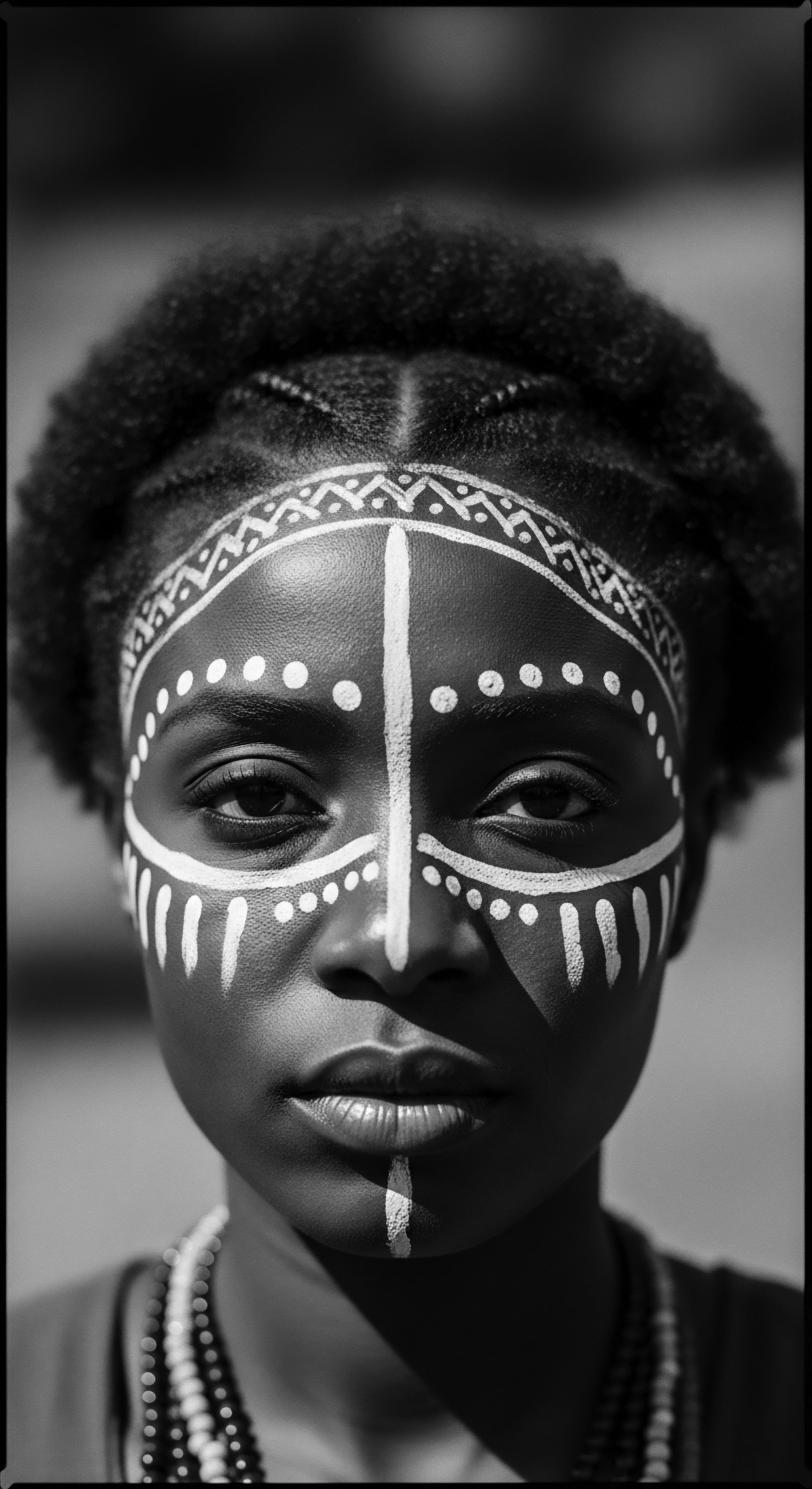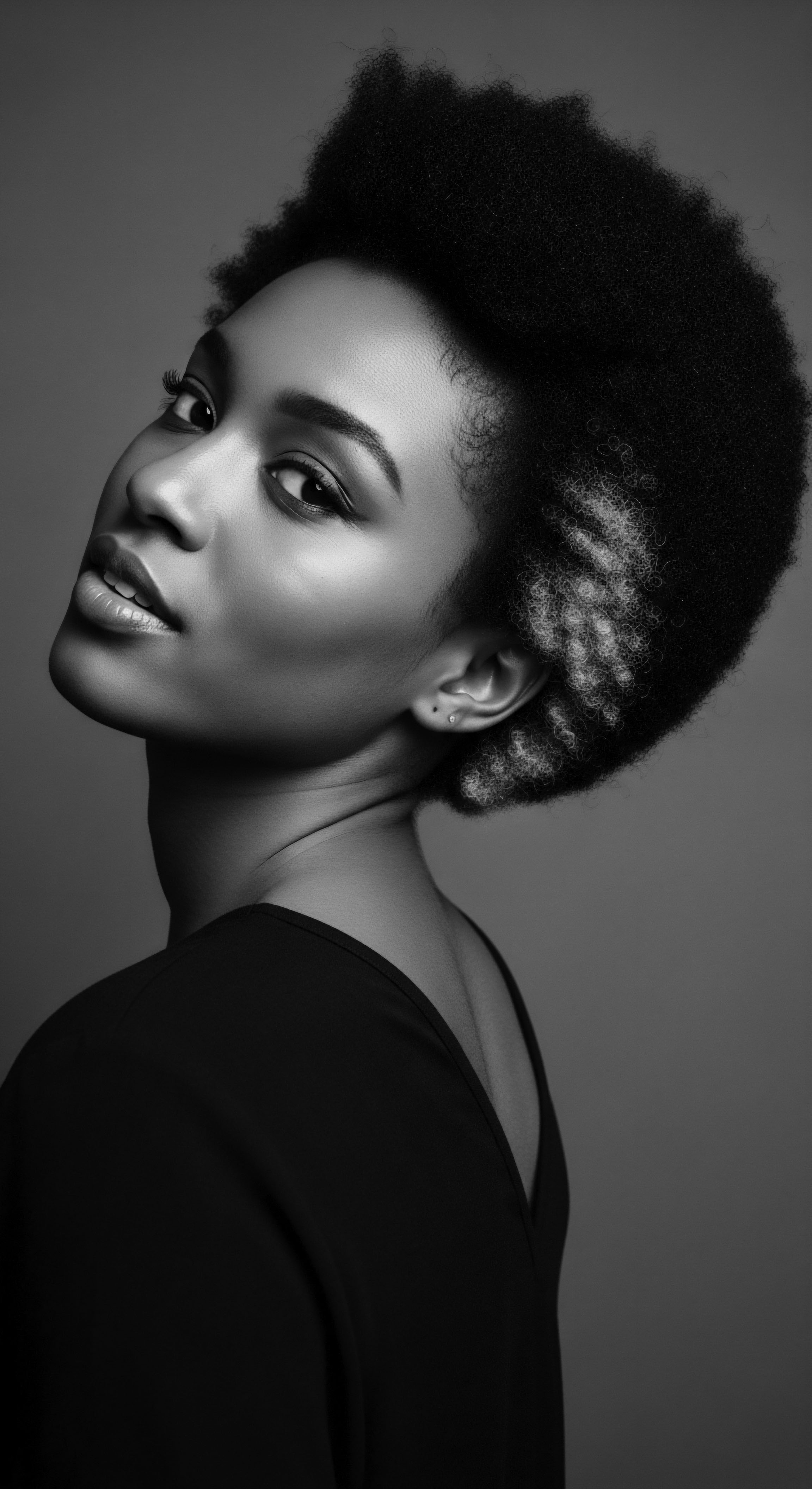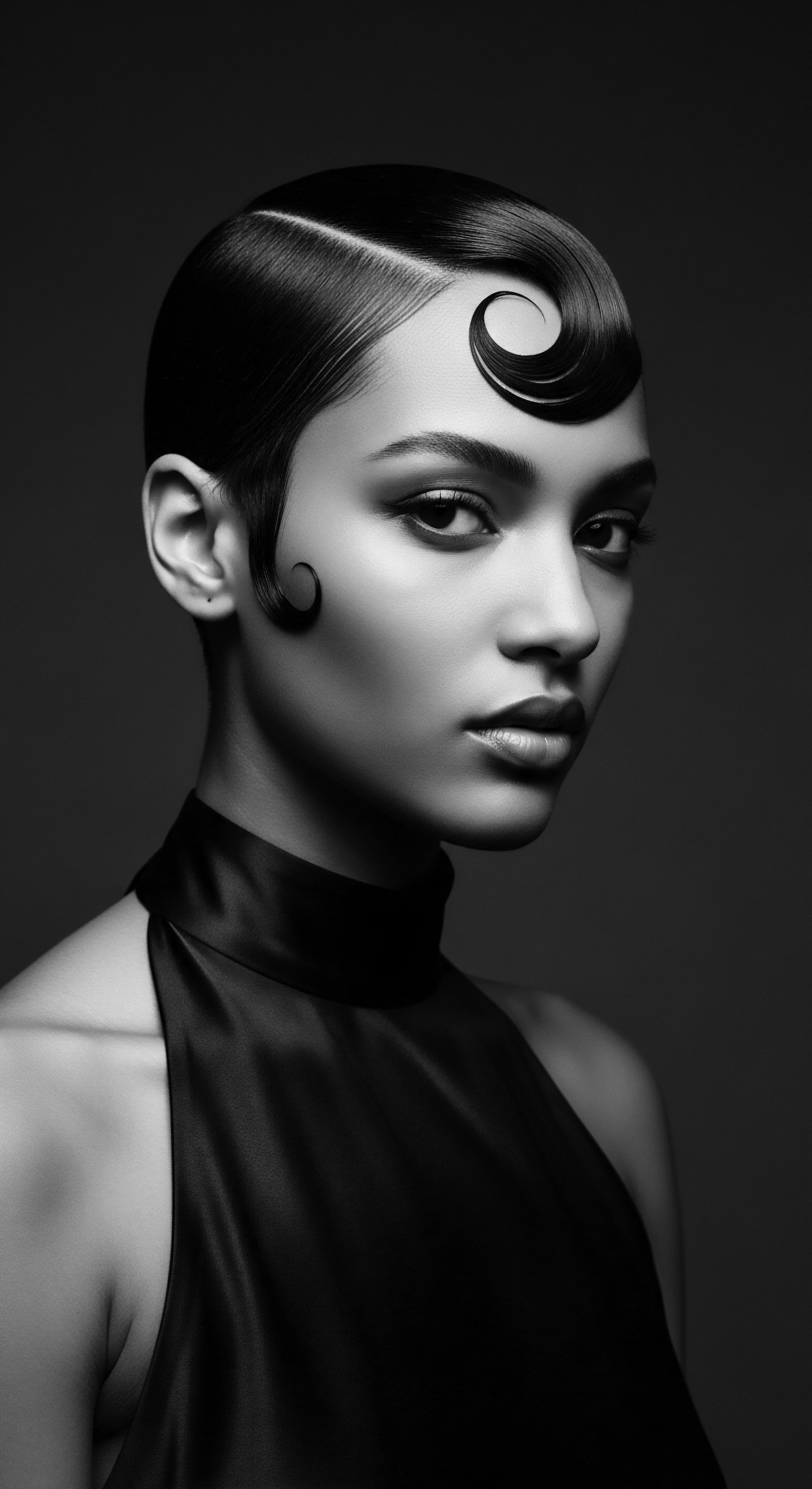
Fundamentals
The Afro-Diasporic Connection stands as a profound link, a living current that binds individuals of African descent across the globe. This connection stretches from the ancient homelands of Africa to every corner of the world where African peoples were dispersed, whether through voluntary migration or the brutal realities of forced displacement. At its most straightforward, it is an explanation of shared heritage, a unifying thread that runs through diverse Black and mixed-race experiences. It speaks to the enduring cultural, social, and spiritual ties that persist despite vast geographical distances and centuries of separation.
The fundamental meaning here lies in recognizing this unbroken lineage, acknowledging that what began on the African continent continues to inform and shape lives, identities, and practices in the present moment. This deep heritage is particularly apparent in the realm of textured hair and its care, a vibrant, tactile archive of ancestral wisdom.
Consider how foundational aspects of identity, often expressed through our appearance, carry historical weight. Hair, especially for peoples of African ancestry, has always been more than mere biological filament; it is a repository of meaning, a statement. Pre-colonial African societies invested immense cultural significance in hairstyles, viewing them as communicators of age, marital status, social rank, wealth, tribal affiliation, and even spiritual beliefs. The intricate artistry of ancient braids and coiled styles conveyed complex narratives, serving as a visual language within communities.
This rich history informs the very fibers of what we today refer to as Afro-Diasporic Connection in the context of hair. It is about understanding that the very act of caring for textured hair, from cleansing rituals to styling choices, echoes practices that span generations and continents.

Early Expressions of Connection Through Hair
Before the shattering disruptions of the transatlantic slave trade, hair in Africa was an extension of self and community, imbued with spiritual powers. People believed hair served as a conduit for spiritual interaction, a way to communicate with divine beings. The process of hair styling often took hours, transforming into a communal activity that strengthened bonds within families and tribes.
This tradition of shared care fostered deep intimacy and transmitted cultural knowledge across generations. The unique texture of African hair, with its inherent versatility for intricate styling, allowed for these elaborate expressions of identity and communal belonging.
- Cultural Mapping ❉ Hairstyles frequently conveyed specific information about an individual’s background, including their ethnic identity or social standing.
- Spiritual Conduit ❉ Many African cultures held that hair, as the highest point of the body, served as a direct link to the heavens and the spiritual realm.
- Communal Bonding ❉ The time-consuming nature of traditional hair care fostered social interactions, building strong community ties through shared grooming rituals.
The simple recognition of a shared hair texture, often misunderstood or denigrated by external gazes, forms a crucial part of this fundamental connection. It prompts a deeper appreciation for the elemental biology that defines textured hair, allowing individuals to recognize their hair as a natural inheritance, rather than something to be altered or subdued. The Afro-Diasporic Connection at this foundational level simply states that the unique characteristics of Black and mixed-race hair are not random; they are genetic echoes of a rich continental past, carrying within their very structure stories of resilience and tradition.
The Afro-Diasporic Connection begins with a recognition of hair as a living archive, carrying the echoes of ancestral practices and shared cultural narratives across generations.

Intermediate
Moving beyond a basic recognition, the intermediate understanding of the Afro-Diasporic Connection unravels its deeper meaning as a complex interplay of historical forces, cultural resilience, and persistent identity. This interpretation acknowledges that the dispersal of African peoples dramatically reshaped hair practices, yet never fully severed the inherited wisdom. It highlights how the care and styling of textured hair became a subtle, powerful form of cultural preservation and resistance, a narrative woven into the very fabric of diasporic life. The Afro-Diasporic Connection, at this level, means appreciating the profound adaptations and innovations in hair care that emerged from conditions of adversity, demonstrating the enduring spirit of communities.

The Impact of Dislocation and Forced Adaptation
The transatlantic slave trade, an unspeakable rupture, profoundly affected hair traditions. Enslaved Africans were often forcibly shorn of their hair upon capture, a dehumanizing act designed to strip away identity and sever cultural ties. This deliberate erasure sought to obliterate the rich symbolism and social functions hair once held in their homelands.
Yet, even in the brutal conditions of enslavement, communities found ways to cling to fragments of their heritage, transforming hair care into acts of quiet rebellion and remembrance. The textures of Black and mixed hair, deemed “unruly” or “unclean” by enslavers, became a focal point for both oppression and defiant cultural expression.
The forced assimilation into new societies presented immense challenges for maintaining traditional practices. Access to ancestral ingredients, tools, and communal grooming rituals vanished. This necessity, however, spurred ingenuity. Enslaved individuals and later, their descendants, adapted available resources, creating new methods of care from what was at hand.
This resourceful spirit, this ability to craft beauty and sustenance from scarcity, forms a core component of the Afro-Diasporic Connection. It underscores a resilience that allowed practices to survive, albeit in altered forms, keeping a whisper of the old ways alive.

Hair as a Medium of Communication and Resistance
Hair became a coded language, particularly during the eras of enslavement. Its styles communicated messages when verbal communication or literacy were dangerous or forbidden. This historical dimension reveals the deeper meaning of the Afro-Diasporic Connection ❉ it signifies a cultural continuity that defied systematic attempts at eradication. It is a testament to human spirit finding expression even in the most constrained circumstances.
The Afro-Diasporic Connection is not simply a historical link; it is a testament to cultural adaptability and a deeply rooted defiance against historical attempts at erasure, particularly evident in the narratives of hair.
One poignant historical example, less commonly known but rigorously documented, is the use of cornrows as literal maps for escape routes by enslaved people in Colombia. In the 17th century, King Benkos Biohó, an African leader captured by the Portuguese, escaped slavery and established San Basilio de Palenque, a free community in northern Colombia. He devised an intelligence network where women would braid intricate designs into their cornrows, covertly depicting paths through forests and mountains. These styles, often called “departes” or “canerows,” served as tangible, tactile guides for those seeking freedom.
Beyond maps, women also concealed gold dust and rice grains within their braids, resources for survival during their arduous journeys. (Hicks, 2021) This powerful act of using hair as a medium of clandestine communication and a means of survival highlights the extraordinary ingenuity and unbreakable spirit embedded within the Afro-Diasporic Connection. This historical reality illustrates that hair, far from being a superficial concern, was a tool of liberation, a silent but potent symbol of collective resistance and enduring hope.
| Pre-Diaspora African Practice Communal Grooming ❉ Hair styling as a social ritual, fostering bonds. |
| Diasporic Adaptation/Significance Covert Communication ❉ Hair braiding used to hide escape routes, seeds, or gold during enslavement. (Hicks, 2021) |
| Pre-Diaspora African Practice Hair as Social Marker ❉ Indicating status, age, marital state. |
| Diasporic Adaptation/Significance Hair as Identity Affirmation ❉ Reclaiming ancestral styles like Afros and locs during civil rights movements to reject Eurocentric norms. |
| Pre-Diaspora African Practice Natural Ingredients ❉ Use of shea butter, plant oils for nourishment. |
| Diasporic Adaptation/Significance Resourceful Solutions ❉ Adaptation of available local botanicals and household items for hair care in new environments. |
| Pre-Diaspora African Practice These transformations demonstrate how the spirit of ancestral care continued, adapting and finding new expressions amidst profound challenges, cementing the Afro-Diasporic Connection. |
The persistence of these practices, from the nuanced language of braids to the later political statements embodied by the Afro during the Civil Rights Movement, solidifies the Afro-Diasporic Connection as a dynamic, living heritage. It is a shared consciousness, passed through generations, that recognizes hair not only as a biological trait but as a cultural artifact, a symbol of survival, and a canvas for self-determination. This intermediate understanding helps one perceive the deep roots of self-perception and the collective memory held within the textured strands.

Academic
The academic understanding of the Afro-Diasporic Connection transcends simple definitions, entering into a rigorous examination of its intricate historical, sociological, biological, and psycho-cultural dimensions. Here, the term delineates a complex, multi-layered phenomenon, signifying the enduring and evolving relationship between African peoples globally, mediated significantly through the socio-cultural meanings and biological realities of textured hair. It is a scholarly delineation that scrutinizes the continuous processes of cultural retention, adaptation, and innovation, alongside the persistent legacies of racialized hierarchy and resistance.
This perspective demands a deep intellectual engagement with how hair serves as a critical semiotic system, a site of contested identity, and a profound manifestation of ancestral memory. The Afro-Diasporic Connection, in this context, is not merely a descriptive phrase; it is an analytical lens through which to comprehend the sustained impact of historical dispersion on identity formation and the lived experiences of Black and mixed-race communities.

Morphology and Sociological Significance of Textured Hair
From an elemental biological standpoint, the unique morphology of Afro-textured hair—characterized by its elliptical cross-section, tightly coiled helical structure, and varying curl patterns—presents distinct inherent properties. This intrinsic biology, a genetic inheritance, forms the physical basis upon which centuries of cultural practices and social meanings have been built. The scientific understanding of these hair characteristics provides a grounding for appreciating traditional care practices.
For instance, the coiled nature of Afro-textured hair means natural oils do not easily travel down the hair shaft, necessitating specific moisturizing techniques like those found in ancestral oiling rituals. These practices, once seen merely as tradition, gain scientific validation when examined through a biological lens.
Sociologically, Afro-Diasporic Connection signifies the shared experience of hair discrimination and the subsequent movements for hair liberation. The systematic subjugation of African peoples during the transatlantic slave trade and colonialism extended to their hair, which was often denigrated as “nappy,” “kinky,” or “unruly,” juxtaposed against Eurocentric ideals of straight, smooth hair. This imposed aesthetic hierarchy established a “good hair” versus “bad hair” dichotomy, deeply embedding itself within the collective psyche of the diaspora.
(Sayes, 2014) This historical disparagement has profoundly influenced Black and mixed-race hair experiences, compelling generations to chemically alter their hair to conform to dominant beauty standards for social and economic acceptance. The Afro-Diasporic Connection, in this light, encapsulates the shared trauma of hair-based discrimination and the collective journey toward self-acceptance and pride.

Hair as a ‘Grammar’ of Identity and Resistance
Sybille Rosado (2003) speaks of a “grammar of hair,” arguing that the intricate symbolism and shared styles among diasporic Africans form a complex communication system, transmitting cultural knowledge and reinforcing group identity. This concept suggests that hair styles are not random; they are deeply semiotic, carrying encoded messages that allow members of the African diaspora to recognize, communicate with, and reinforce bonds with one another across vast geographical and cultural divides. This interpretative framework provides a powerful way to comprehend how collective consciousness is built and sustained through visual and material culture.
The historical example of cornrows serving as maps for escape during slavery in Colombia stands as a particularly compelling case study of this “grammar of hair” in action, underscoring the deep utility and multi-dimensional significance of hair within the Afro-Diasporic Connection. King Benkos Biohó, a visionary leader of the Maroons who established San Basilio de Palenque in the 17th century, is credited with devising an ingenious system wherein the patterns of cornrows braided by women conveyed topographical information, essentially providing escapees with literal routes to freedom. (Hicks, 2021) This practice was not merely a matter of aesthetic choice; it was a sophisticated act of communication and survival in the face of brutal oppression.
The women would meticulously craft specific styles, their curved braids illustrating paths through dense vegetation or around guarded plantations, while seeds or gold particles were often woven within the strands, offering sustenance and currency for life in their new, autonomous communities. (Garcia, 2020; Shanghie, 2019)
This historical reality provides a potent illustration of how hair, a biological attribute, became an active agent in human liberation. It was a silent testament to profound ancestral wisdom and collective ingenuity. The cornrow maps represent a zenith of hair as both a cultural artifact and a tool for resistance, revealing a deep understanding of spatial navigation and clandestine communication that was transmitted through a seemingly innocuous medium. This instance offers a powerful counter-narrative to the dominant historical discourse that often minimized the agency of enslaved peoples.
It elevates hair care from a personal grooming activity to a strategic, life-saving practice, grounding the Afro-Diasporic Connection in tangible acts of defiance and self-preservation. Such examples compel academic inquiry to consider hair not as a passive canvas, but as a dynamic participant in the making of history and the forging of diasporic identities.
- Cultural Resilience ❉ The enduring presence of traditional African hairstyles, even in modified forms, in diasporic communities demonstrates a powerful retention of cultural practices despite disruption.
- Identity Formation ❉ Hair choices within the diaspora are intricately tied to self-perception, group affiliation, and a reclaiming of Black identity.
- Economic and Social Ramifications ❉ Historically, hair discrimination has limited educational and employment opportunities for Black individuals, reinforcing socio-economic disparities.
- Biocultural Linkages ❉ Modern science’s understanding of textured hair morphology offers deeper insight into why traditional care methods, refined over generations, were inherently effective.
The Afro-Diasporic Connection also encompasses the reciprocal influence between historical hair practices and modern hair science. Contemporary research in cosmetology and trichology often finds scientific validation for long-standing ancestral remedies, such as the use of natural oils (like shea butter and coconut oil) and plant extracts for scalp health and hair nourishment. These ingredients, which were staples in traditional African hair care, are now being re-evaluated for their efficacy, bridging ancient wisdom with scientific understanding. This convergence highlights that the ancestral practices were not simply folk remedies, but sophisticated systems of care developed through generations of empirical observation and embodied knowledge.
The continuing legacy of the Afro-Diasporic Connection is also evident in contemporary movements, such as the natural hair movement, which actively rejects Eurocentric beauty standards and promotes the embrace of natural textures. This movement, gaining momentum through digital platforms, represents a contemporary reassertion of ancestral identity and a powerful collective agency. It signifies a conscious choice to honor heritage through daily practice, transforming personal hair choices into public statements of pride and belonging. The academic investigation of the Afro-Diasporic Connection therefore offers a nuanced appreciation of how hair continues to serve as a symbol, a battleground, and a celebration of a rich, complex, and unyielding heritage.

Reflection on the Heritage of Afro-Diasporic Connection
As we trace the intricate pathways of the Afro-Diasporic Connection, particularly through the lens of textured hair, we come to recognize a profound truth ❉ heritage is not a static relic of the past, but a living, breathing current that flows through the present and shapes the future. The strands themselves become keepers of stories, each coil and curl bearing witness to journeys both triumphant and challenging. From the ceremonial artistry of ancient African coiffures, signaling status and spiritual reverence, to the clandestine maps woven into cornrows for freedom, the history of Black and mixed-race hair stands as an enduring testament to the ingenuity and fortitude of a people. This enduring wisdom, passed through generations, informs our modern understanding of care, beauty, and identity.
The understanding gleaned from examining the Afro-Diasporic Connection offers more than historical insight; it provides a framework for holistic wellness. When we tend to our textured hair, recognizing its unique biology and honoring its ancestral lineage, we engage in an act of self-reverence. We connect with the collective memory of those who preserved traditions against immense odds, finding solace and strength in their enduring spirit.
This sensitivity to the deep past allows us to see how the very act of washing, oiling, and styling our hair becomes a ritual, a continuation of practices born from ancient hearths and carried across oceans. It allows us to feel the resonant narrative appeal of a heritage that defied breakage and emerged, time and again, stronger and more vibrant.
The journey of Afro-Diasporic hair is a powerful metaphor for the human spirit’s capacity for resilience. It is a story of how beauty standards, once imposed, are being defiantly rewritten, strand by strand. It reflects a lucid connection between elemental biology and profound cultural context.
As Roothea, we stand at the nexus of this heritage, observing how the echoes from the source—the biological roots and ancient practices—continue to inspire the tender thread of living traditions and community care. Ultimately, this understanding guides us towards the unbound helix, where identity finds its most authentic voice and shapes futures brimming with self-acceptance, cultural pride, and ancestral reverence.

References
- Byrd, A. & Tharps, L. L. (2014). Hair Story ❉ Untangling the Roots of Black Hair in America. St. Martin’s Press.
- Dabiri, E. (2020). Don’t Touch My Hair. Harper Perennial.
- Hicks, M. (2021, May 20). How Braids Were Used By Enslaved People To Escape In South America. Travel Noire.
- Nyela, O. (2021). Braided Archives ❉ Black hair as a site of diasporic transindividuation. York University.
- Rosado, S. (2003). The Symbolic Grammar of Hair ❉ The Politics of Black Women’s Hair in the African Diaspora. Palgrave Macmillan.
- Shanghie, S. (2019, February 27). When a Hairstyle Is … Freedom. Truth Be Told.
- Sieber, R. & Herreman, F. (2000). Hair in African Art and Culture. Museum for African Art.
- Thompson, S. L. (2009). Black Women, Hair, and Identity ❉ A Critical Cultural Studies Perspective. Peter Lang.
